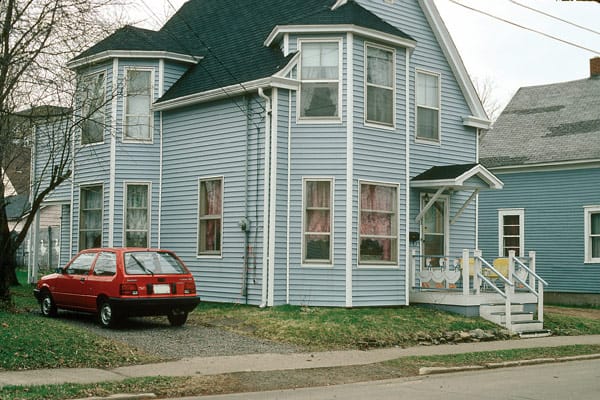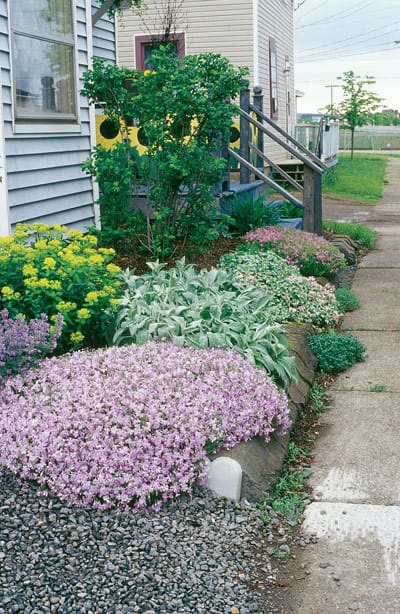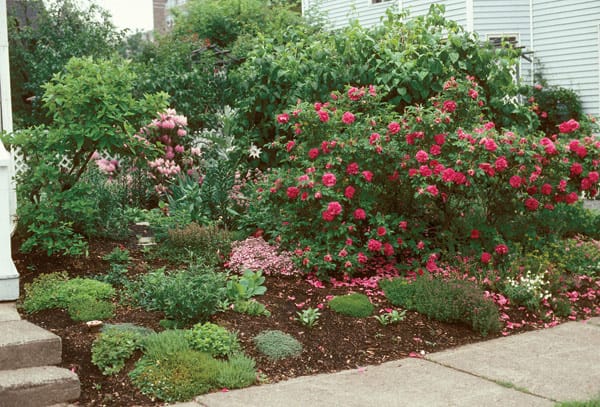Shedding the Lawn
Why mow all summer when you can just sit back and smell the roses?
George Griffin got tired of mowing his lawn. So last year the avid gardener ripped it up. Every blessed blade of grass was removed from his front yard in downtown Moncton to make way for a no-mow combination of perennial ground covers and plants. Out went the Kentucky Blue and in went such plants as ajuga, thyme, lamium, periwinkle and ground cover roses.
“There is a strong moving interest in it,” says Griffin, past president of the Westmorland Horticultural Society. “The baby boomers are tired of fighting with grass. In order to keep up that lawn, you have to use poisons and people are getting very conscious of using poisons. With ground covers, you don’t have that.”
Demographics are also playing a role.“That generation is getting older. They don’t want to spend three hours a week mowing the lawn. Some people have medical conditions and just can’t do it anymore.”

The traditional green rectangle we call our lawn is changing.
Opting for the more eco-friendly yard
Since the early part of the 20th century, North Americans have embraced the idea that front yards should consist of turf grass, shrubs, and the occasional tree. Over time, zoning laws pushed houses farther back from the street, leaving vast areas of grass (and dandelions). During the same period, backyards moved from being utility and parking areas to highly developed outdoor spaces. Front lawns were no longer needed for recreation.
In the last decade, homeowners, environmentally conscious of the energy and chemical costs associated with a lawn, have begun adding flower gardens to their large front yards. About five years ago, another horticultural movement began creeping across the continent pushing the notion of ridding the front lawn of grass altogether by displacing it with flowers, rock gardens, and native plants.
A University of Guelph study in 2001 found the number of alternative lawns, where grass takes up less than 20 per cent of the space, increased between 300 and 900 per cent in the past five years in that Ontario city.
The study’s authors described a growing movement across Canada. In New Brunswick, however, the expanse of lawn still dominates, according to Neil Pond, a horticulturist and owner of a private landscaping company in the Kennebecasis Valley.
“But,” he says, “there is a lot more awareness today of the different options available for covering the lawn… Today people are more conscious of perennials and plants and incorporating ground covers as a component to their property.”
He has not, however, seen many homeowners replacing their turf entirely with ground covers. In most cases, Pond finds homeowners have more grass than they need. Lawns are often as large as they are, he says, simply for lack of a better idea. When a house lot is developed, there’s usually just a lot of empty space left around the building “and for the lack of any other ideas, people simply cover it with lawn.”

Alternatives for lawn mixtures
In many cases, lawns aren’t installed as well as they should be—lacking sufficient quality topsoil to sustain a healthy turf. As a result, the grass becomes infested with weeds and burns brown in summer—sometimes prompting homeowners to resort to a chemical fix.
“People who are more forward-thinking would probably plan that step a little more and not have as much lawn. And they would incorporate ground covers in some of the more difficult areas,” Pond says.
“But I don’t see the movement here that we’ve seen in the United States, where people are avoiding lawns altogether and putting in all these other plants.” And he’s not sure if the concept will ever root in the Atlantic Provinces, for that matter, because of our temperate seasons.
Instead, homeowners may see an evolution in the available varieties of grass and plants that will become acceptable in the lawn. For example, decades ago, clover was a standard ingredient in lawns. With the advent of golf courses, clover, a nitrogen-fixer, became unfashionable. In the United States, Kentucky blue grass has been replaced with a turf-like, tall fescue that is easy to grow, requires less maintenance, and is resistant to chinch bugs. (Unfortunately, it’s not hardy enough for Zone 4.)
One man’s lawn-less adventure
 Back in Moncton, George Griffin is confident his mix of ground covers will provide the functionality of turf without the fuss.With some study and planning, he planted a dozen or so different ground covers, all of which provide weed suppression and are winter hardy.
Back in Moncton, George Griffin is confident his mix of ground covers will provide the functionality of turf without the fuss.With some study and planning, he planted a dozen or so different ground covers, all of which provide weed suppression and are winter hardy.
Near the front, he planted tight cover plants that grow only a few centimetres high. As the eye moves toward his century-old farmhouse, the plants rise in height to meet an old lilac bush, which he underplanted with nine different kinds of clematis. Some clematis will scramble through the lilac branches and bloom after the bush has finished putting on its own display, and others, considered ground cover varieties, will scramble over the yard.
Even though the front garden is only entering its second year, the ground covers have filled in. Last summer, they covered 80 per cent of the space, and he’s expecting this year they’ll fill the yard.
George believes his new front yard is more interesting than a wide and featureless expanse of green. Besides their contrasting leaf shapes and leaf colours, the ground covers bloom flowers that attract butterflies and birds—and each year they knot themselves into a new patchwork of colour and form. Even from week to week, there are changes.
“It’s fun to watch it,” Griffin said. “Every year I can hardly wait to see what kind of different things have happened.
“A lawn is bland… except when it needs to be mowed.
“This is so dynamic because there are so many different kinds of plants growing in amongst each other that they are all sort of reacting to each other and blending in. And then one is taking over the other so that you never know what it’s going to look like the next year.”
Others in his city neighbourhood are beginning to follow suit. Here and there lawns are being replaced by shrubs and flowerbeds.
“It’s not for everybody,” Griffin said, “but down here in the city I’m noticing it more and more. People walk by it and they like it. They just never thought about doing it. And some like it for the fact that it is more environmentally friendly.”
“I’d much rather go out with a cup of coffee and pull the odd weed and enjoy the gardens than I would start up a noisy, exhaust-spewing mower.”
Choices for Lawn Replacement
But all those plants and shrubs are expensive.
Think again!
George Griffin installed his no-mow front yard for about $20. He bought some plants, begged some gardeners for others, and traded for some at local plant swaps.
“Plant swaps are good places to pick up fast-growing ground covers because people thin them out.”
Spacing them about 45-centimetres apart, Griffin planted the tighter, low-growing ground covers at the front of his lawn and gradually increased their height as they moved toward his home.
“It looks sparse at first and you just don’t imagine it’s going to turn into what it does,” he said.
He chose about a dozen different kinds of ground covers, all of which are winter hardy to Zone 4. Among them are:
Ajuga reptans (or bugleweed) – a spreading mat of rosette foliage that produces upright clusters of blue flowers in early summer. It prefers partial sun to shade, and is hardy to Zone 3. A number of cultivars are on the market, including ‘Bronze Beauty’ with bronze foliage and blue flowers; ‘Alba’ which has white flowers and light green foliage; ‘Multicolour Rainbow’ with red, white, yellow and purple foliage and ‘Pink Beauty’ with pink flowers.
Pink pewter Lamium (or dead nettle) – a low-growing perennial with dark green leaves with white centres. Short spikes of pink flowers bloom from spring through summer. Hardy to Zone 3, this perennial grows 20 inches high, spreads 60 centimetres and tolerates shade.
Phlox stolonifera (or creeping ground phlox) – a broad mat of foliage producing sheets of lavish spring colour. This ground cover spreads rapidly on stems that root where nodes touch the ground. A Zone 3 plant, it tolerates shade and dappled shade.
Thymus serpyllum (creeping thyme) – growing only two to four inches high, this plant tolerates foot traffic and is therefore good between flagstones. Its leaves are small but dense, and one plant can cover a 60-centimetre area. It flowers in late spring with flowers in shades of lavender, red, rose or white. Will tolerate full sun to full shade, with fewer blooms.
Sedum - a large genus that includes many species, including those used for ground covers. Succulents with thick, fleshy leaves, they require full sun.
Periwinkle(Vinca major) – a vigorous evergreen carpeter with glossy leaves. Tolerant of dense shade, this plant produces flowers in shades of white, blue, lavender and red in April and June. Some cultivars have variegated leaves.
Irish moss (Sagina Subulata) – fine-textured, ground hugging, slightly mounded plants that resemble moss and tolerate foot traffic. Tiny white flowers appear in spring or summer. Needs afternoon shade and moist soil. Hardy to zone 5.
Groundcover roses – roses that are short in stature, but wide in girth. Many grow no higher than half a metre, but can extend their reach to two metres. Although not dense enough to choke out weeds, they produce a massive show of flowers in summer. Varieties include Snow Carpet with white blooms, Max Graf with single pink blooms and Rosa Paulii with white blooms.
Daylilies (Hemerocallis) – a versatile perennial that can act as a ground cover. With thousands of cultivars, the blooms come in shades of yellow, red, orange, maroon and white in late summer. Its fountain of leaves is handsome all season. Daylilies thrive in full sun or part shade.
